Gravlax
Gravlax is one of my favorite salmon preparations--the salmon is cured in sugar, salt, and herbs (usually pepper and dill) for a few days. It's sort of like smoked salmon or lox, in that it's cooked by curing rather than by heat, but it has a different flavor and texture--not quite as oily as smoked salmon, and a more translucent and delicate. I think the lineage of this method comes from burying salmon on a sandy beach in Nordic waters until it gets preserved by the brine, or so I've read. Salmon season is going strong in the northwest, so there's lots of very fresh and beautiful wild-caught salmon in the markets. Our friends Demi, Eric and their girls were coming over on Saturday night, so we decided to make some gravlax. I stopped by Pure Food Fish in the Pike Place market on Wednesday afternoon after work and bought a whole wild-caught King salmon. The guys at Pure Food Fish fileted the fish for me when I bought it. I don't think this is something that should be attempted with skanky farmed salmon filets that have been sitting in a styrofoam tray wrapped in plastic in the supermarket!
On Wednesday night, we prepared the gravlax. We started out with the fileted salmon.
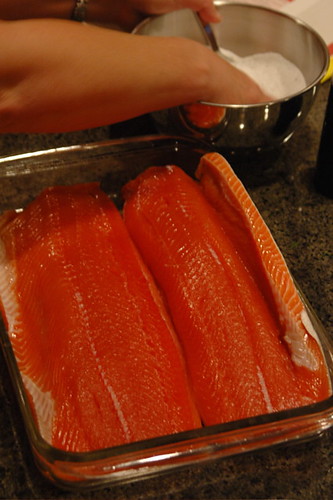
There are varying opinions on the proportions of sugar to salt. We ended up following the Mark Bittman's advice from How to Cook Everything: 2 cups of sugar to 1 cup of salt, though he calls for brown sugar, and we used white sugar. The sugar and salt are mixed with some cracked black pepper, and that gets rubbed into both sides of the filets.
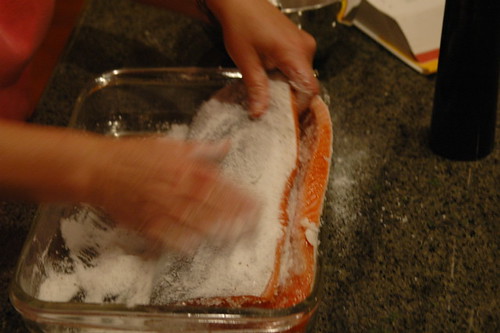
Then Debbie added 1/4 cup Hangar One Buddha's Hand Citron vodka, which is amazing vodka that's handmade in a hangar on the old airbase in Alameda, California.
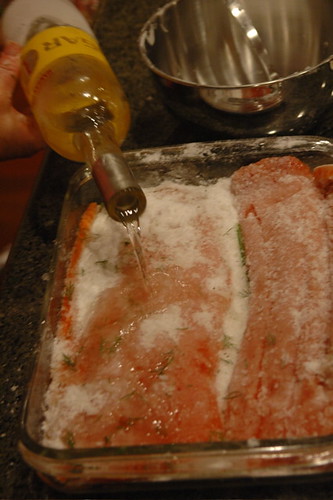
Finally, we added a couple of bunches of roughly chopped dill in between and on top of the filets, wrapped them in plastic, and then weighted them down with something heavy (we used rocks from the garden). They stayed in the fridge for a day.
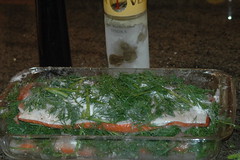
After a day the weights came off, and we basted the filets with the accumulated liquid that gets wicked out of the salmon by the brine. After two or three days, the filets get translucent and firm. At this point, we took the filets out and rinsed off all of the liquid and dill. I don't have a proper knife for slicing cured fish. My first attempt used a chef's knife, which didn't work very well because the blade is too wide and the fish sticks to it. It could have been prettier, but tasted amazing.
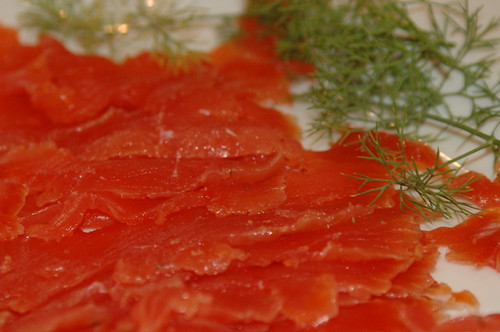
We served one filet that night, with dense black bread and big round flat rye crackers from the Swedish store in Ballard, along with mustard-dill sauce that Debbie made. With it we drank a Chardonnay from Navarro. After the gravlax we had a butterflied leg of lamb with a coarse tapenade of olives, pine nuts, and basil. The trick for the lamb is to cook it over indirect coals until almost done, let it sit for about 20 minutes, and then cook it for another few minutes over direct heat. Dessert was pound cake and ice cream with Suyematsu Farms (local) raspberries, raspberry coulis made from the leftovers of the previous 1/2 flat of the same raspberries, and chocolate and caramel sauces from Fran's.
On Wednesday night, we prepared the gravlax. We started out with the fileted salmon.

There are varying opinions on the proportions of sugar to salt. We ended up following the Mark Bittman's advice from How to Cook Everything: 2 cups of sugar to 1 cup of salt, though he calls for brown sugar, and we used white sugar. The sugar and salt are mixed with some cracked black pepper, and that gets rubbed into both sides of the filets.

Then Debbie added 1/4 cup Hangar One Buddha's Hand Citron vodka, which is amazing vodka that's handmade in a hangar on the old airbase in Alameda, California.

Finally, we added a couple of bunches of roughly chopped dill in between and on top of the filets, wrapped them in plastic, and then weighted them down with something heavy (we used rocks from the garden). They stayed in the fridge for a day.

After a day the weights came off, and we basted the filets with the accumulated liquid that gets wicked out of the salmon by the brine. After two or three days, the filets get translucent and firm. At this point, we took the filets out and rinsed off all of the liquid and dill. I don't have a proper knife for slicing cured fish. My first attempt used a chef's knife, which didn't work very well because the blade is too wide and the fish sticks to it. It could have been prettier, but tasted amazing.

We served one filet that night, with dense black bread and big round flat rye crackers from the Swedish store in Ballard, along with mustard-dill sauce that Debbie made. With it we drank a Chardonnay from Navarro. After the gravlax we had a butterflied leg of lamb with a coarse tapenade of olives, pine nuts, and basil. The trick for the lamb is to cook it over indirect coals until almost done, let it sit for about 20 minutes, and then cook it for another few minutes over direct heat. Dessert was pound cake and ice cream with Suyematsu Farms (local) raspberries, raspberry coulis made from the leftovers of the previous 1/2 flat of the same raspberries, and chocolate and caramel sauces from Fran's.

